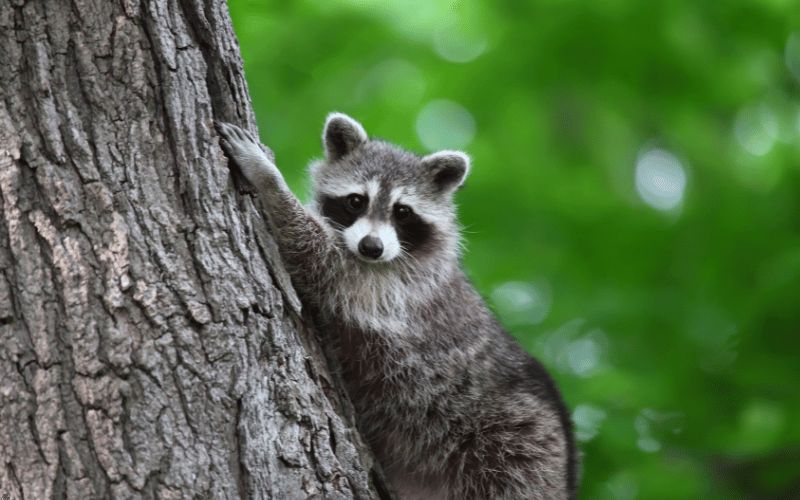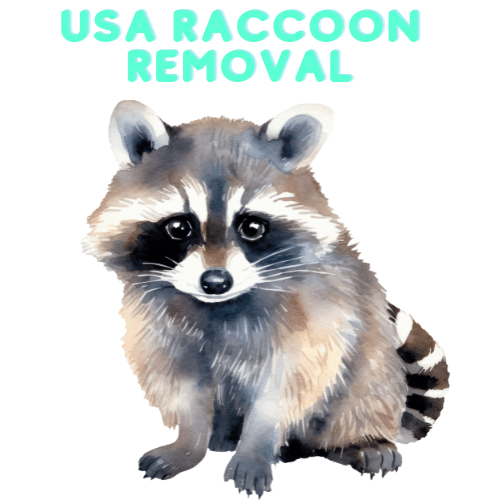

I’m here to share my expertise on a common urban wildlife challenge: raccoons making homes in our trees. These creatures are more than just curious visitors; they’re adaptable survivors that have learned to thrive in urban settings, much to the chagrin of homeowners.
Raccoons are naturally drawn to areas that provide shelter and food, and unfortunately, that often includes urban and suburban landscapes. Trees in these environments can offer an ideal habitat for raccoons, particularly if they have hollow sections or dense foliage.
The safety and height of trees provide protection from predators and a quiet place for mothers to raise their young.
Seasonal shifts play a role, too. Spring and summer are prime times for raccoons to seek out nesting sites, and trees are among their top choices.
As fall approaches, they’re preparing for winter, and a cozy tree can seem like the perfect spot to hunker down.
With this context, you’ll better understand why raccoons choose to reside in your tree and how you might effectively and humanely encourage them to find a more appropriate home.
It’s crucial, as their presence is more than just a nuisance — it can carry real risks, which will lead us into the next section.

The Risks of Raccoon Infestations in Residential Areas
While raccoons may appear cute and harmless, their presence near homes can lead to several issues. Safety is my primary concern, and awareness is crucial. Here, I’ll discuss the risks raccoons bring to residential areas.
Property damage is a significant risk. Raccoons are curious and dexterous, often prying into roofs, vents, and garbage bins. Their strong claws can tear through roofing materials, siding, and shingles, potentially leading to costly home repairs.
Next, let’s consider health risks. Raccoons carry diseases such as rabies, leptospirosis, and roundworm, which can be transmitted to humans and pets. Their droppings, which may contain harmful parasites, should not be taken lightly.
Interactions with raccoons can be hazardous, especially since they can exhibit aggressive behavior when cornered or protecting their young. Even pets can be at risk of injury or disease from altercations with these wildlife intruders.
Despite these risks, it’s important to remember that raccoons play a role in our urban ecosystem. They are natural scavengers, which contributes to the health and balance of local environments. Hence, I advocate for humane removal solutions.
With a clear understanding of these potential threats, you’ll be better equipped to manage a raccoon situation responsibly. In the following section, I’ll guide you through identifying the signs that indicate a raccoon has made your tree its home.
Identifying Signs of a Raccoon in Your Tree
I know the uneasy feeling when something seems amiss in your backyard. You’ve been noticing odd noises or disturbances, and now you’re worried that a raccoon has taken up residence in your tree. Recognizing the signs is a crucial step before you can take action.
First, be on the lookout for droppings around the base of the tree. Raccoon feces are dark and tubular and may contain undigested food particles.
Aside from being unpleasant to find, these droppings can pose health risks, carrying diseases like leptospirosis or roundworm.
Next, examine your tree for signs of damage. Raccoons have sharp claws that they use to climb and make nests. Look for scratch marks on the bark or branches that may appear broken or disturbed.
Another giveaway is the noises. If you hear chattering, growling, or heavy rustling in the leaves, especially during the nighttime, there’s a good chance you have a nocturnal visitor.
It’s common to see raccoons in urban areas, so you might also spot them physically – look for a masked face and a bushy ringed tail. Remember, these animals are clever and can be quite bold, so it’s best to keep a safe distance.
If these signs confirm your suspicions, it’s time to consider your removal options. The next article section, ‘Humane and Ethical Raccoon Removal Methods’, will guide you on how to responsibly deal with your furry friend without causing them harm.
Humane and Ethical Raccoon Removal Methods
When you notice a furry bandit has set up residence in your tree, it’s crucial to handle the situation with care.
The goal is to encourage the raccoon to relocate rather than causing it harm. Before taking action, check your local laws regarding wildlife removal, as it’s both a matter of ethics and compliance.
The first step is to eliminate whatever is attracting the raccoon. Secure your trash cans, keep pet food indoors, and remove any bird feeders temporarily.
Next, consider using humane deterrents. These can include motion-activated sprinklers, ultrasonic noise machines, or even placing ammonia-soaked rags near the tree, as the smell can be a natural deterrent.
If these methods don’t do the trick, it’s time to call in professionals. Wildlife removal experts can use safe, humane traps to capture and relocate the raccoon. They have the skills to ensure that the process is stress-free for the animal and safe for everyone involved.
Remember, mother raccoons may have babies nearby, so it’s important to be particularly careful in the spring. A professional can ensure that families aren’t separated, which is key for the raccoon’s survival and well-being.
Once the raccoon is removed, you’ll need to take steps to prevent future visitors. Let’s move on to how you can secure your trees and property against repeat raccoon infestations.
Post-Removal: Securing Your Trees Against Future Infestations
Now, imagine you’ve successfully removed a raccoon from your tree. You’re probably relieved, but your job isn’t done yet. It’s crucial to take steps to prevent these clever creatures from returning.
Let’s start with the basics: proper yard maintenance. Keep your trees pruned and your ground clear of debris. Raccoons love to find cozy, hidden spots to nest, and overgrown branches or piles of leaves can offer just that.
Consider installing animal-proof barriers. These can be metal bands around the trunk of a tree, which prevent racoons from climbing. Remember to periodically check these barriers for damage or displacement.
Remove all potential food sources. Raccoons are opportunistic feeders and will be attracted to your yard if there is easy access to food. Secure your garbage cans with locking lids and don’t leave pet food outdoors.
If the raccoon was nesting, thoroughly clean the area. Raccoon waste can be harmful to humans and pets, and the scent may attract other wildlife.
Lastly, it may be wise to consult a professional. An arborist can help with proper tree care, while a wildlife control expert can offer specific advice on keeping raccoons at bay.
Frequently Asked Questions About Raccoon Removal
After addressing the essentials of raccoon behavior, the risks involved, identifying signs, and the removal process, you may still have questions.
I understand that dealing with wildlife, especially within the boundaries of your property, can be complex and sometimes emotional. That’s why I’ve compiled the most common inquiries that homeowners have.
One key question is, ‘Is it safe to remove racoons on my own?’ The answer is usually NO. It’s generally safer and more humane to rely on professional services. ‘What time of year are racoons most active?’ People ask.
Typically, spring and fall are peak times. Another question I hear a lot is, ‘Will racoons leave on their own?’ Sometimes they might, but a proactive approach is recommended to prevent damage and health concerns.
Many also wonder if raccoons come back after removal. Unfortunately, they can, which is why preventive measures are essential.
And finally, ‘Where can I learn more about living harmoniously with urban wildlife?’ There are numerous resources online and organizations dedicated to wildlife education.
I hope this article has provided clarity and practical advice for your raccoon concerns.
Remember, while removing raccoons from your tree, always prioritize humane methods and consideration for the animal’s well-being. Protect your home, respect the wildlife, and when in doubt, seek professional advice for SAFE and EFFECTIVE solutions.


